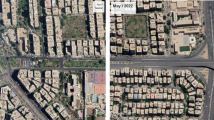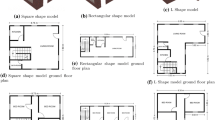Abstract
The spaces must be designed in accordance with certain design principles for people to feel comfortable. In accordance with that, building ventilation is particularly important during hot periods to ensure thermal comfort. In this study, the effect of ventilation realized using a wind tower on the thermal quality of a classroom was investigated. In the study, two popular models (unidirectional and multidirectional wind tower) were studied, and the model that provided more ergonomic ventilation to sitting users based on climate conditions of the province of Trabzon (Turkey) during the month of August was determined. The more efficient model was studied further. Some dimensional changes in width, height, and shelf height were applied to it to find a model that provided more comfort for the used thermal conditions. The models were modelled and simulated using ANSYS FLUENT. Velocity distributions were generated to ease the interpretation of the results. With the calculated average wind speeds in different regions in the classroom, the thermal sensation in the space was evaluated. Furthermore, the thermal perception of users of the retained model was evaluated by entering thermal comfort parameter values calculated for the relevant region into the CBE thermal comfort tool available online. The change in the dimensional features of the wind tower had an impact on wind tower performance. Ventilation provided by wind towers under the thermal conditions of Trabzon in August often caused thermal discomfort.
Similar content being viewed by others
Abbreviations
- k :
-
turbulent kinetic energy
- ε :
-
rate of dissipation of turbulent kinetic energy
- ω :
-
specific rate of dissipation
- CBE:
-
Center for The Built Environment
- BM1:
-
base model 1 (unidirectional)
- BM2:
-
base model 2 (multidirectional)
- MH1:
-
model with wind tower height of 1 m
- MH5:
-
model with wind tower height of 5 m
- MW1.5:
-
model with wind tower width of 1.5 m
- MW2:
-
model with wind tower width of 2 m
- MO0.5:
-
model with wind tower of 0.5 m opening size
- MO2:
-
model with wind tower of 2 m opening size
- PMV:
-
predicted mean vote
- PPD:
-
predicted percentage dissatisfied
References
Abdaei K, Azami A (2013). Sustainability analyses of passive cooling systems in Iranian traditional buildings approaching wind-catchers. In: Zaharim A, Panagopoulos T, Zhang Y, et al. (eds), Recent Advances in Energy, Environment and Development. Athens, Greece: WSEAS Press. pp. 124–129.
Calautit JK, Hughes BR, Chaudhry HN, et al. (2013). CFD analysis of a heat transfer device integrated wind tower system for hot and dry climate. Applied Energy, 112: 576–591.
Chan HY, Riffat SB, Zhu J (2010). Review of passive solar heating and cooling technologies. Renewable and Sustainable Energy Reviews, 14: 781–789.
Chaudhry HN, Calautit JK, Hughes BR (2015). Computational analysis of a wind tower assisted passive cooling technology for the built environment. Journal of Building Engineering, 1: 63–71.
Ghadiri HM, Ibrahim NLN, Dehnavi M (2011). The effect of tower height in square plan wind catcher on its thermal behavior. Australian Journal of Basic and Applied Sciences, 5(9): 381–385.
Ghadiri HM, Lukman N, Ibrahim N, Farid MM (2014). Applying computational fluid dynamic to evaluate the performance of four-sided rectangular wind catcher with different height. Research Journal of Applied Sciences, Engineering and Technology, 7: 502–509.
Haghighi AP, Pakdel SH, Jafari A (2016). A study of a wind catcher assisted adsorption cooling channel for natural cooling of a 2-storey building. Energy, 102: 118–138.
Hosseini SH, Shokry E, Ahmadian Hosseini AJ, et al. (2016). Evaluation of airflow and thermal comfort in buildings ventilated with wind catchers: Simulation of conditions in Yazd City, Iran. Energy for Sustainable Development, 35: 7–24.
Hughes BR, Mak CM (2011). A study of wind and buoyancy driven flows through commercial wind towers. Energy and Buildings, 43: 1784–1791.
Jomehzadeh F, Nejat P, Calautit JK, et al. (2017). A review on windcatcher for passive cooling and natural ventilation in buildings, Part 1: Indoor air quality and thermal comfort assessment. Renewable and Sustainable Energy Reviews, 70: 736–756.
Kavraz M (2017). Rüzgâr kulelerinin teknik ve estetik açidan değerlendirilmesi: iran’da yezd kenti örneği. In: Proceedings of 3.Uluslararası Sosyal Bilimler Sempozyumu, Kahramanmaraş, Turkey. (in Turkish)
Mahdavinejad M, Javanroodi K (2014). Natural ventilation performance of ancient wind catchers, an experimental and analytical study — case studies: one-sided, two-sided and four-sided wind catchers. International Journal of Energy Technology and Policy, 10: 36–60.
Mahyari A (1996). The wind catcher a passive cooling device for hot arid climate. PhD Thesis, The University of Sydney, Australia.
Maleki BA, Shabestari AF (2010). Optimization of ‘Badgir (wind tower)’ in Iranian hot-arid region architecture. In: Proceedings of Conference on Technology & Sustainability in the Built Environment.
Montazeri H, Montazeri F, Azizian R, et al. (2010). Two-sided wind catcher performance evaluation using experimental, numerical and analytical modeling. Renewable Energy, 35: 1424–1435.
Montazeri H (2011). Experimental and numerical study on natural ventilation performance of various multi-opening wind catchers. Building and Environment, 46: 370–378.
Montazeri H, Montazeri F (2018). CFD simulation of cross-ventilation in buildings using rooftop wind-catchers: Impact of outlet openings. Renewable Energy, 118: 502–520.
Nahal EH (2014). Investigation of the Middle East windcatchers and (comparison between windcatchers in Iran and Egypt in terms of components). International Journal of Architecture and Urban Development, 4: 87–94.
Neufert E, Neufert P (2000). Architects’ Data, 3rd edn. Oxford, UK: Blackwell Science.
Pirhayati M, Ainechi S, Torkjazi M, et al. (2013). Ancient Iran, the origin land of wind catcher in the world. Research Journal of Environmental and Earth Sciences, 5: 433–439.
Reyes VA, Moya SL, Morales JM, et al. (2013). A study of air flow and heat transfer in building-wind tower passive cooling systems applied to arid and semi-arid regions of Mexico. Energy and Buildings, 66: 211–221.
Rutledge K, Ramroop T, Boudreau D, et al. (2019). Air Pollution. National Geographic. Available at https://www.nationalgeographic.org/encyclopedia/air-pollution. Accessed 30 Jan 2019.
Sheikhshahrokhdehkordi M, Khalesi J, Goudarzi N (2020). Highperformance building: Sensitivity analysis for simulating different combinations of components of a two-sided windcatcher. Journal of Building Engineering, 28: 101079.
T.C. Tarım ve Orman Bakanlığı (2019). Aylık ortalama nispi nem, rüzgar hızı ve sıcaklık. Meteoroloji Genel Müdürlüğü, 11. Bölge Müdürlüğü. (in Turkish)
Yang T, Clements-Croome DJ (2020). Natural ventilation in built environment. In: Loftness V (ed), Sustainable Built Environments. New York: Springer US. pp. 431–464.
Zarandi MM (2009). Analysis on Iranian wind catcher and its effect on natural ventilation as a solution towards sustainable architecture (Case Study: Yazd). International Journal of Social, Behavioral, Educational, Economic, Business and Industrial Engineering, 3: 668–673.
Author information
Authors and Affiliations
Corresponding author
Rights and permissions
About this article
Cite this article
Rabeharivelo, R., Kavraz, M. & Aygün, C. Thermal comfort in classrooms considering a traditional wind tower in Trabzon through simulation. Build. Simul. 15, 401–418 (2022). https://doi.org/10.1007/s12273-021-0804-9
Received:
Revised:
Accepted:
Published:
Issue Date:
DOI: https://doi.org/10.1007/s12273-021-0804-9




